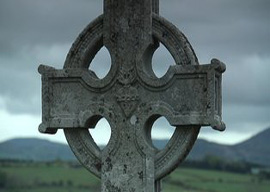
November 23, 2011

One would have to look back to General Ludendorff’s lumping together of the Freemasons and the Jesuits to find as ahistorical a premise. Those who hold these views seek a new Irish identity purged of both British and Catholic influences. What detritus would be left is unclear; nevertheless, this orientation was to be found in Irish elementary-school textbooks at least as early as the 1980s.
The attempt by Ireland’s elites to minimize Catholicism in national life far predates the recent awful disclosures regarding clerical sexual misconduct—indeed, to the 1972 removal of the Fifth Amendment to the Irish Constitution. The last few holders of the largely ceremonial but influential Irish presidency have reveled in their attempts to secularize Ireland: Mary Robinson touted her hatred of Ireland’s then-dominant social mores; Mary McAleese followed in her train, taking communion in the Anglican Church of Ireland. Symbolic of the ideological change in Ireland’s leadership, Dublin Castle’s formerly Anglican Chapel Royal, a barometer of the elite’s religiosity (made over by Éamon de Valera into the Catholic Church of the Holy Trinity in 1943) was turned into an ecumenical chapel without worship services of any kind. Longtime Fianna Fáil Taoiseach Bertie Ahern led by example, living publicly with his mistress, Celia Larkin, while attending Mass even more publicly. The elites pummeled their subjects with successive referenda on divorce until they at last received the results they wanted.
These moves did not go unopposed; such stalwarts as Justin Barrett, Patricia Casey, Richard Greene, Nora Bennis, and the young activists of Youth Defence took up the challenge. But this opposition was small, divided, and subjected to continuous attacks by the media and the two major parties—a pattern not unknown elsewhere.
Long before the scandals, the bishops—by their silence—mostly acquiesced in Ireland’s transformation into something new and strange. McAleese and Ahern might receive verbal reprimands for their misdeeds, but that was it—no excommunications for exceptionally public acts. But anyone with knowledge of either the Irish episcopate or the Church at large was surprised. The sad truth is that the pope has only as much control over the local diocese as the bishop is pleased to give him—as widespread blockage of Benedict XVI’s attempt to make the Tridentine Mass available to all painfully underlines. The Irish bishops have been among the most disobedient in Europe, if not the world; if the pope cannot make them conform in matters of liturgy and catechetics, how could he with regard to morals?
Irish elites’ hypocrisy on the issue is sickening. But today’s Irish Republic is surely not what Patrick Pearse and Joseph Plunkett died for. Given the lightweights in the current governing classes, it is little surprise that Queen Elizabeth II outshone them all during her recent visit. Perhaps henceforth the pope should deal with Dublin solely through the London Nunciature.